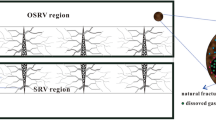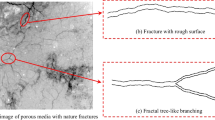Abstract
In order to study gas transport properties of fractured shale gas reservoirs for the accurate estimation of shale gas production, a new multiscale fractal transport model with an effective porosity model was proposed based on the fractal theory and the multilayer fractal Frenkel–Halsey–Hill (FHH) adsorption. In shale matrix, both fractal microstructures of pores (such as pore size distribution, flow path tortuosity, and pore surface roughness) and multiscale flow mechanisms (including slip flow and Knudsen diffusion) were coupled. In fracture network, fractal fracture length distribution, stress compaction, and gas pressure were introduced to formulate a new fracture permeability model. These permeability and effective porosity models were then incorporated into the governing equations of gas flow and the deformation equation of reservoirs to form a numerical model. This numerical model was solved within COMSOL Multiphysics for shale gas recovery. Both transport models in shale matrix and fracture network were validated by experimental data or compared with other models. Finally, sensitivity analysis was conducted to identify key parameters to gas recovery enhancement. It was found that the multilayer gas adsorption and fractal microstructures have great impacts on gas production in shale reservoirs. The cumulative gas production can be increased by 26% after 8000 days when the multilayer adsorbed gas is considered. Larger surface fractal dimension and larger tortuosity fractal dimension represent more roughness pore surface, higher flow resistance, and lower cumulative gas production. Bigger pore diameter fractal dimension means more pores, higher permeability, and higher cumulative gas production. Our model with fractal FHH adsorption was in better agreements with field data from Marcellus and Barnett shale reservoirs than other models.















Similar content being viewed by others
References
Ahmad, A.L., Mustafa, N.N.: Pore surface fractal analysis of palladium-alumina ceramic membrane using Frenkel–Halsey–Hill (FHH) model. J. Colloid Interface Sci. 301(2), 575–584 (2006)
Beskok, A., Karniadakis, G.: Report: a model for flows in channels, pipes, and ducts at micro and nano scales. Microscale Thermophys. Eng. 3(1), 43–77 (1999)
Brunauer, S., Emmett, P., Teller, E.: Adsorption of gases in multimolecular layers. J. Am. Chem. Soc. 60, 309–319 (1938)
Cai, J., Lin, D., Singh, H., Wei, W., Zhou, S.: Shale gas transport model in 3D fractal porous media with variable pore sizes. Mar. Pet. Geol. 98, 437–447 (2018)
Cai, J., Yu, B.: A discussion of the effect of tortuosity on the capillary imbibition in porous media. Transp. Porous Media 89(2), 251–263 (2011)
Cao, R., Wang, Y., Cheng, L., Ma, Y.Z., Tian, X., An, N.: A new model for determining the effective permeability of tight formation. Transp. Porous Media 112(1), 21–37 (2016)
Civan, F.: Effective correlation of apparent gas permeability in tight porous media. Transp. Porous Media 82(2), 375–384 (2010)
Cui, X., Bustin, R.M.: Volumetric strain associated with methane desorption and its impact on coalbed gas production from deep coal seams. AAPG Bull. 89(89), 1181–1202 (2005)
Darabi, H., Ettehad, A., Javadpour, F., Sepehrnoori, K.: Gas flow in ultra-tight shale strata. J. Fluid Mech. 710(12), 641–658 (2012)
Eftekhari, B., Marder, M., Patzek, T.: Field data provide estimates of effective permeability, fracture spacing, well drainage area and incremental production in gas shales. J. Nat. Gas Sci. Eng. 56, 141–151 (2018)
Fan, D., Ettehadtavakkol, A.: Semi-analytical modeling of shale gas flow through fractal induced fracture networks with microseismic data. Fuel 193, 444–459 (2017)
Ghanbarian, B., Javadpour, F.: Upscaling pore pressure-dependent gas permeability in shales. J. Geophys. Res. Solid Earth 122(4), 2541–2552 (2017)
Ghanbarian, B., Perfect, E., Liu, H.: A geometrical aperture-width relationship for rock fractures. Fractals. 27(1), 1940002 (2019)
Hu, B., Wang, J.G., Wu, D., Wang, H.: Impacts of zone fractal properties on shale gas productivity of a multiple fractured horizontal well. Fractals. 27(2), 1950006 (2019). https://doi.org/10.1142/S0218348X19500063
Hunt, A., Ghanbarian, B., Saville, K.: Unsaturated hydraulic conductivity modeling for porous media with two fractal regimes. Geoderma 207, 268–278 (2013)
Javadpour, F.: Nanopores and apparent permeability of gas flow in mudrocks (shales and siltstone). J. Can. Pet. Technol. 48(8), 16–21 (2009)
Jia, B., Li, D., Tsau, J.S., Barati, R.: Gas permeability evolution during production in the Marcellus and Eagle Ford shales: coupling diffusion/slip-flow, geomechanics, and adsorption/desorption. In: SPE/AAPG/SEG Unconventional Resources Technology Conference, 24–26 July, Austin, Texas, USA (2017)
Karniadakis, G.E., Beskok, A., Aluru, N.R.: MicroFlows and Nanoflows—Fundamentals and Simulation. Interdisciplinary Applied Mathematics Series. Springer, New York (2005)
Klimczak, C., Schultz, R.A., Parashar, R., Reeves, D.M.: Cubic law with aperture-length correlation: implications for network scale fluid flow. Hydrogeol. J. 18(4), 851–862 (2010)
Klinkenberg, L.J.: The permeability of porous media to liquids and gases. Socar Proc. 2(2), 200–213 (1941)
Lee, S., Fischer, T.B., Stokes, M.R., Klingler, R.J., Ilavsky, J., Mccarty, D.K., Wigand, M.O., Derkowski, A., Winans, R.E.: Dehydration effect on the pore size, porosity, and fractal parameters of shale rocks: ultrasmall-angle x-ray scattering study. Energy Fuels 28(11), 6772–6779 (2014)
Lim, K.T., Aziz, K.: Matrix-fracture transfer shape factors for dual-porosity simulators. J. Pet. Sci. Eng. 13(3–4), 169–178 (1995)
Liu, K., Ostadhassan, M.: Multi-scale fractal analysis of pores in shale rocks. J. Appl. Geophys. 140, 1–10 (2017)
Liu, R., Li, B., Jiang, Y., Huang, N.: Review: mathematical expressions for estimating equivalent permeability of rock fracture networks. Hydrogeol. J. 24, 1623–1649 (2016)
Mengal, S., Wattenbarger, R.: Accounting for adsorbed gas in shale gas reservoirs. Society of Petroleum Engineers. SPE-141085-MS (2011) https://doi.org/10.2118/141085-ms
Miao, T., Yu, B., Duan, Y., Fang, Q.: A fractal analysis of permeability for fractured rocks. Int. J. Heat Mass Transf. 81(81), 75–80 (2015)
Michel, G., Sigal, R., Civan, F., Devegowda, D.: Parametric investigation of shale gas production considering nano-scale pore size distribution, formation factor, and non-Darcy flow mechanisms. In: SPE Technical Conference & Exhibition. Society of Petroleum Engineers (2011) https://doi.org/10.2118/147438-ms
Miller, A.A.: The Variance of Methane Adsorption and Its Relation to Thermal Maturity in the Marcellus Shale. Master’s thesis, University of Texas at Arlington (2015)
Millán, H., Govea-Alcaide, E., García-Fornaris, I.: Truncated fractal modeling of H2O-vapor adsorption isotherms. Geoderma 206, 14–23 (2013)
Neuzil, C.E., Tracy, J.V.: Flow through fractures. Water Resour. Res. 17(1), 191–199 (1981)
Olson, J.E.: Sublinear scaling of fracture aperture versus length: an exception or the rule? J. Geophys. Res. Solid Earth. (2003). https://doi.org/10.1029/2001jb000419
Pang, Y., Soliman, M.Y., Deng, H., Emadi, H.: Analysis of effective porosity and effective permeability in shale-gas reservoirs with consideration of gas adsorption and stress effects. SPE J. 26(2), 1739–1759 (2017)
Patzek, T., Male, F., Marder, M.: A simple model of gas production from hydrofractured horizontal wells in shales. AAPG Bull. 98(12), 2507–2529 (2014)
Patzek, T., Male, F., Marder, M.: Gas production in the Barnett shale obeys a simple scaling theory. Proc. Natl. A Sci. 110(49), 19731–19736 (2013)
Pfeifer, P., Obert, M., Cole, M.W.: Fractal BET and FHH theories of adsorption: a comparative study. Proc. R. Soc. Lond. A 423, 169–188 (1989a). https://doi.org/10.1098/rspa.1989.0049
Pfeifer, P., Wu, Y.J., Cole, M.W., Krim, J.: Multilayer adsorption on a fractally rough surface. Phys. Rev. Lett. 62(17), 1997–2000 (1989b). https://doi.org/10.1103/PhysRevLett.62
Sheng, G., Javadpour, F., Su, Y.: Effect of microscale compressibility on apparent porosity and permeability in shale gas reservoirs. Int. J. Heat Mass Transf. 120, 56–65 (2018)
Sun, H., Yao, J., Fan, D.Y., Wang, C.C., Sun, Z.: Gas transport mode criteria in ultra-tight porous media. Int. J. Heat Mass Transf. 83, 192–199 (2015)
Tan, X.H., Kui, M.Q., Li, X.P., Mao, Z.L., Xiao, H.: Permeability and porosity models of bi-fractal porous media. Int. J. Mod. Phys. B 31(29), 1750219 (2017)
Turcio, M., Reyes, J.M., Camacho, R., Lira-Galeana, C., Vargas, R.O., Manero, O.: Calculation of effective permeability for the BMP model in fractal porous media. J. Pet. Sci. Eng. 103(3), 51–60 (2013)
Vajda, P., Felinger, A.: Multilayer adsorption on fractal surfaces. J. Chromatogr. A 1324, 121–127 (2014)
Wang, F., Liu, Z., Jiao, L., Wang, C., Guo, H.: A fractal permeability model coupling boundary-layer effect for tight oil reservoirs. Fractals 25(3), 1750042 (2017)
Wang, J., Hu, B., Liu, H., Han, Y., Liu, J.: Effects of ‘soft-hard’ compaction and multiscale flow on the shale gas production from a multistage hydraulic fractured horizontal well. J. Pet. Sci. Eng. 170, 873–887 (2018)
Warpinksi, N., Teufel, L.: Influence of geologic discontinuities on hydraulic fracture propagation. J. Pet. Technol. 39(2), 209–220 (1987). https://doi.org/10.2118/13224-PA
Wu, J., Yu, B.: A fractal resistance model for flow through porous media. Int. J. Heat Mass Transf. 71(3), 331–343 (2008)
Wu, K., Li, X., Guo, C., Chen, Z.: Adsorbed gas surface diffusion and bulk gas transport in nanopores of shale reservoirs with real gas effect-adsorption-mechanical coupling. SPE Reservoir Simulation Symposium 23–25 February, Houston, Texas, USA. SPE-173201-MS (2015) https://doi.org/10.2118/173201-ms
Xia, Y., Cai, J., Wei, W., Hu, X., Wang, X., Ge, X.: A new method for calculating fractal dimensions of porous media based on pore size distribution. Fractals 26(3), 1850006 (2018)
Xu, P., Yu, B.: Developing a new form of permeability and Kozeny–Carman constant for homogeneous porous media by means of fractal geometry. Adv. Water Resour. 31(1), 74–81 (2008)
Yang, C., Zhang, J., Wang, X., Tang, X., Chen, Y., Jiang, L., Gong, X.: Nanoscale pore structure and fractal characteristics of marine-continental transitional shale: a case study from the lower permian Shanxi shale in the southeastern ordos basin, China. Mar. Pet. Geol. 88, 54–68 (2017)
Yeager, B., Meyer, B.: Injection/fall-off testing in the Marcellus shale: using reservoir knowledge to improve operational efficiency. In: SPE 139067, Presented at SPE Eastern Regional Meeting, October 12–14, Morgantown, WV (2010). https://doi.org/10.2118/139067-ms
Yu, B., Cheng, P.: A fractal permeability model for bi-dispersed porous media. Int J. Heat Mass Transf. 45(14), 2983–2993 (2002)
Yu, B., Li, J.: Some fractal characters of porous media. Fractals 9(03), 365–372 (2001)
Yu, W., Sepehrnoori, K.: Simulation of gas desorption and geomechanics effects for unconventional gas reservoirs. Fuel 116(1), 455–464 (2014)
Yu, W., Sepehrnoori, K., Patzek, T.: Modeling gas adsorption in marcellus shale with Langmuir and BET Isotherms. SPE J. 21(2), 589–600 (2016)
Yu, W., Zhang, T., Song, D., Sepehrnoori, K.: Numerical study of the effect of uneven proppant distribution between multiple fractures on shale gas well performance. Fuel 142, 189–198 (2015)
Zamirian, M., Aminian, K., Ameri, S., Fathi, E.: New steady-state technique for measuring shale core plug permeability. Society of Petroleum Engineers, SPE-171613-MS (2014). https://doi.org/10.2118/171613-ms
Zhang, J., Li, X., Wei, Q., Sun, K., Zhang, G., Wang, F.: Characterization of full-sized pore structure and fractal characteristics of marine–continental transitional Longtan formation shale of Sichuan basin, South China. Energy Fuels 30(10), 10490–10504 (2017)
Zhang, L., Li, J., Tang, H., Guo, J.: Fractal pore structure model and multilayer fractal adsorption in shale. Fractals 22(03), 1440010 (2014)
Zheng, Q., Fan, J., Li, X., Wang, S.: Fractal model of gas diffusion in fractured porous media. Fractals 26(3), 1850035 (2018)
Zhou, S., Xue, H., Ning, Y., Guo, W., Zhang, Q.: Experimental study of supercritical methane adsorption in Longmaxi shale: insights into the density of adsorbed methane. Fuel 211, 140–148 (2018)
Acknowledgements
The authors are grateful to the financial support from the Fundamental Research Funds for the Central Universities (Grant No. 2018ZZCX04).
Author information
Authors and Affiliations
Corresponding author
Additional information
Publisher's Note
Springer Nature remains neutral with regard to jurisdictional claims in published maps and institutional affiliations.
Appendices
Appendix A: Calculation of Adsorbed Gas Porosity
The gas amount of adsorption per unit mass of shale V (m3/kg) can be written as
The mass of gas adsorbed per unit shale volume \( m_{\text{ads}} \) (kg/m3) is
where \( V_{\text{std}} \) is the molar volume of gas at standard conditions, m3/mol. Thus, the porosity of adsorbed gas \( \phi_{\text{ads}} \), which is the volume of adsorbed gas per unit shale volume, is expressed as
Appendix B: Two Permeability Models and Their Computational Parameters
The permeability model proposed by Sun et al. (2015) is
and
The parameters used in Sun’s model in Fig. 4 are listed in Table 7.
The permeability model proposed by Darabi et al. (2012) is
The parameters used in Darabi’s model in Fig. 4 are listed in Table 8.
Rights and permissions
About this article
Cite this article
Wang, J.G., Hu, B., Wu, D. et al. A Multiscale Fractal Transport Model with Multilayer Sorption and Effective Porosity Effects. Transp Porous Med 129, 25–51 (2019). https://doi.org/10.1007/s11242-019-01276-0
Received:
Accepted:
Published:
Issue Date:
DOI: https://doi.org/10.1007/s11242-019-01276-0




